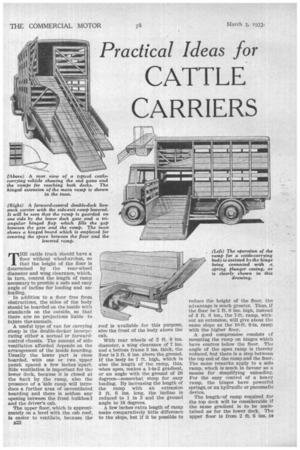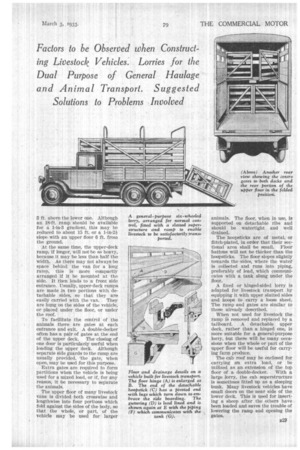Practical Ideas for
Page 40

Page 41

If you've noticed an error in this article please click here to report it so we can fix it.
CATTLE CARRIERS
Factors to be Observed when Constructing Livestock Vehicles. Lorries for the Dual Purpose of General Haulage and Animal Transport. Suggested Solutions to Problems Involved
TEIE cattle truck should have a floor without wheel-arches, so that the height of the floor is determined by the rear-wheel diameter and wing clearance, which, in turn, control the length of ramp necessary to provide a safe and easy angle of incline for loading and unloading.
• In addition to a floor free from obstructions, the sides of the body should be boarded on the inside with standards on the outside, so that there are. no projections liable to injure the, animals.
A useful type of van for carrying sheep is the double-decker incorporating either a normal or forwardcontrol chassis. The amount of side ventilation afforded depends on the arrangement of the inside boarding. Usually the lower part is close boarded, with one or two upper paneh spaced a few inches 'apart. Side ventilation is important for the lower deck, because it is closed at the back by the ramp, also the presence of a 'side ramp will introduce a further area of unventilated boarding and there is seldom any opening between the front bulkhead and the driver's cab.
The upper floor, which is approximately on a level with the cab roof, is easier to ventilate, because the
n22
roof is available for this purpose, also the front of the body above the cab.
With rear wheels of 2 ft. 8 ins. diameter, a wing clearance of 7 ins. and a bottom frame 3 ins, thick, the floor is 3 ft. 6 ins, above the ground. If the body be 7 ft. high, which is also the length of the ramp, this, when open, makes a 1-in-2 gradient, or an angle with the ground of 26 degrees—somewhat steep for easy loading. By increasing the length of the ramp with an extension 3 ft. 6 ins, long, the incline is reduced to 1 in 3 and the ground angle to 18 degrees.
A few inches extra length of ramp make comparatively little difference to the slope, but if it be possible to reduce the height of the floor, the advantage is much greater. Thus, if the floor be 2 ft. 6 ins, high, instead of 3 ft. 6 ins., the 7-ft. ramp, without an extension, will give about the same slope as the 10-ft. 6-in. ramp with the higher floor.
A good compromise consists a mounting the ramp on hinges which have centres below the floor. The angle of the open ramp is thereby reduced, but there is a step between the top end of the ramp and the floor. The same remarks apply to a side ramp, which is much in favour as a means for simplifying unloading. For the easy control of a heavy ramp, the hinges have powerful springs, or an hydraulic or pneumatic device.
The Iengthoof ramp required for the top deck will be considerable if the same gradient is to be maintained as for the lower deck. The upper floor is from 2 ft. 6 ins. to 3 ft. above the lower one. Although an 18-ft. ramp should be available for a 1-in-3 gradient, this may be reduced to about 15 ft. or a 1-in-2 slope with an upper floor 13 ft. from the ground.
At the same time, the upper-deck ramp, if longer, will not be so heavy, because it may be less than half the width. As there may not always be space behind the van for a long ramp, this is more 'compactly arranged if it be mounted at the side. It then leads to a front side entrance. Usually, upper-deck ramps are made in two portions with detachable sides, so that they are easily carried with the van. They are hUng on the sides of the vehicle, or placed under the floor, or under the roof.
To facilitate the control of the animals there are gates at each entrance and exit. A double-decker often has a pair of gates at the end of the upper deck. The closing of one door is particularly useful when loading the upper deck. Although separate side guards to the ramp are usually provided, The gate, when open, may be used for this purpose.
Extra gates are required to form partitions when the vehicle is being used for a mixed load, or if, for any reason, it be necessary to seParate the animals.
The upper floor of many livestock vans is divided both crosswise and lengthwise into four portions •which fold against the sides of the body, so that the whole, or part, of the vehicle may be used for larger
animals. The floor, when in use, is supported on detachable ribs and Should be watertight and well drained.
The hoopsticks are of metal, or flitch-plated, in order that their sectional area shall be small. Floor battens will not be thicker than the hoopsticks. The floor slopes slightly towards the ,sides, where the water is collected and runs into piping, preferably of lead, which communicates with a tank slung under the floor.
A fixed or hinged-sided lorry is adapted for livestock transport by equipping it with upper slatted sides and hoops to carry a loose sheet. The ramp and gates are similar to those already described.
When not used for livestock the ramp i removed and replaced by a tailboard. A detachable upper deck, rather than a hinged one, is more suitable for a general-purpose lorry, but there will be many occasions when the whole or part of the upper floor will be useful for carrying farm produce.
The ,cab roof may be enclosed for carrying an extra load, or be utilized as an extension of the top floor of a ciouble-decker. With a large lorry, the cab superstructure is sometimes fitted up as a sleeping bunk. Many livestock vehicles have small doors on the near side of the lower deck. This is used for inserting a sheep after the •others have been loaded and saves the trouble of lowering the ramp and opening the gates. .




































































































